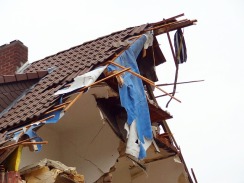
Builder’s Risk Insurance is an insurance policy that either a Contractor or Owner takes out for the duration of construction to cover loss of anything built or materials for building under that construction contract. It would cover losses due to theft, wind damage, hail damage, lightning, or other acts of God. It may cover fire damage if the fire was caused by something other than negligence. It also covers  whether the materials are on site, in storage, or in transit – but it does not cover “soft costs” (costs which are not considered direct construction costs, such as financing, legal fees, interest, etc.).
whether the materials are on site, in storage, or in transit – but it does not cover “soft costs” (costs which are not considered direct construction costs, such as financing, legal fees, interest, etc.).
This differs from a Contractor’s General Liability Insurance policy in a few ways. General Liability would be used for any accident or damage due to negligence on the part of the contractor or subcontractors. General Liability also follows the Contractor from job to job and does not “end” when a project ends. Builder’s Risk ends when the project is substantially complete, and the building is officially handed over to the Owner.
What does this mean?
It means several things. When the project is substantially complete, an Owner has to be ready to take over insurance of the building or improvement on their property insurance in order to maintain continuous coverage. It also might mean that if the property insurance has “improvement” listed in its policy before construction, that you may not need Builder’s Risk to begin with. Or if the construction project is cosmetic only (finishes and furniture) then Builder’s Risk generally is not needed either.
 However, if the project is not covered by property insurance, but is a renovation located in a larger structure, it is important to figure out if everything is covered between both policies. The last thing anyone wants is to have damage to a building during an ongoing renovation and find out that neither insurance will cover the loss because of gaps between the policies.
However, if the project is not covered by property insurance, but is a renovation located in a larger structure, it is important to figure out if everything is covered between both policies. The last thing anyone wants is to have damage to a building during an ongoing renovation and find out that neither insurance will cover the loss because of gaps between the policies.
As with most things, transparency between entities before a project is bid or before construction begins can save money and hassles down the line.
Other things to keep in mind:
- The Owner always wants to be listed as additionally insured on Builder’s Risk if the Contractor takes out the policy.
- Sometimes the Owner can get Builder’s Risk cheaper than the Contractor. The only way to know is to have both priced out! However, this is generally not recommended because the responsibility of the Contractor’s materials should generally be placed on the Contractor and not the Owner.
- The Architect needs to know, prior to bidding, what insurances are required of the Contractor and what they need to cover (or not cover) so the bids will be comparable and the specifications and contract are written properly.

Pingback: 7 Ways Construction Might Go Wrong (and how you’re covered) | Labarre Associates, Inc.